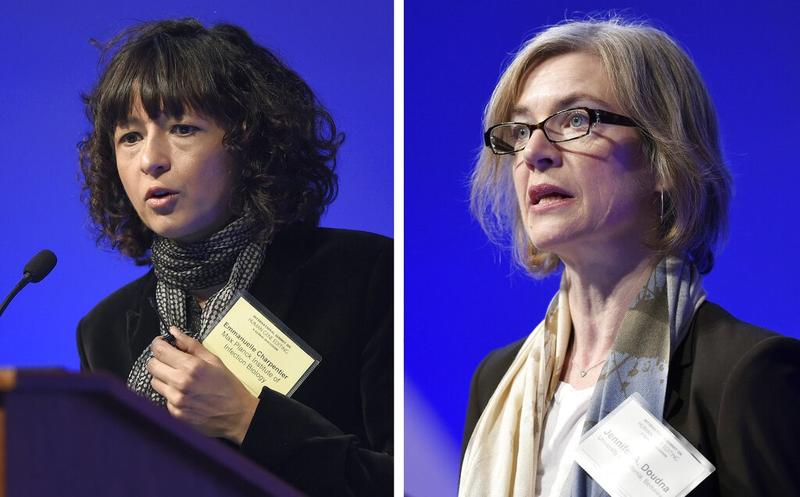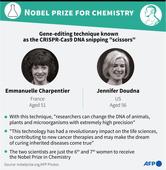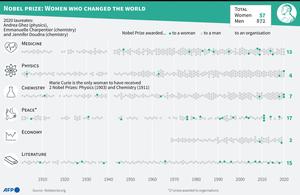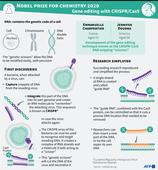 This Dec 1, 2015 file combo image shows Emmanuelle Charpentier, left, and Jennifer Doudna, both speaking at the National Academy of Sciences international summit on the safety and ethics of human gene editing, in Washington. (SUSAN WALSH / AP)
This Dec 1, 2015 file combo image shows Emmanuelle Charpentier, left, and Jennifer Doudna, both speaking at the National Academy of Sciences international summit on the safety and ethics of human gene editing, in Washington. (SUSAN WALSH / AP)
STOCKHOLM/BERLIN - Two scientists won the 2020 Nobel Prize in Chemistry on Wednesday for creating genetic ‘scissors’ that can rewrite the code of life, contributing to new cancer therapies and holding out the prospect of curing hereditary diseases.
Emmanuelle Charpentier, who is French, and American Jennifer Doudna share the 10 million Swedish crown (US$1.1 million) prize for developing the CRISPR/Cas9 tool to edit the DNA of animals, plants and microorganisms with precision.
Emmanuelle Charpentier, who is French, and American Jennifer Doudna share the 10 million Swedish crown (US$1.1 million) prize for developing the CRISPR/Cas9 tool to edit the DNA of animals, plants and microorganisms with precision
ALSO READ: 3 win Nobel in Chemistry for work on lithium-ion batteries
“The ability to cut the DNA where you want has revolutionized the life sciences,” Pernilla Wittung Stafshede of the Swedish Academy of Sciences told an award ceremony.
Charpentier, 51, and Doudna, 56, become the sixth and seventh women to win a Nobel for chemistry, joining Marie Curie, who won in 1911, and more recently, Frances Arnold, in 2018.
It is the first time since 1964, when Britain’s Dorothy Crowfoot Hodgkin alone won the award, that no men are among the chemistry prize winners.
In keeping with tradition, chemistry is the third prize announced every year and follows those for medicine and physics earlier this week.
Charpentier, of the Max Planck Unit for the Science of Pathogens, told journalists in Berlin she was “extremely emotional and extremely moved” by the award, which came as a complete surprise even though she had been tipped as contender.
The first Nobel won by two women showed how “science becomes more modern and develops more female leaders”, she said after setting down a glass of wine to pose for the cameras alongside a bust of Planck, the 1918 Physics Nobel laureate.
READ MORE: Briton and two Americans win 2018 Nobel Chemistry Prize
Doudna is already employing CRISPR in the battle against the coronavirus as co-founder of biotech startup Mammoth, which has tied up with GlaxoSmithKline to develop a test to detect infections.
CONTROVERSIAL FIELD
The path from discovery to prize has taken less than a decade - a relatively short period by Nobel standards.

And, although CRISPR had been tipped to win the Chemistry prize, there has also been concern that the technology conferred God-like powers on scientists and could be misused, for example, to create ‘designer babies’.
“The enormous power of this technology means that we need to use it with great care,” said Claes Gustafsson, chair of the Nobel Committee for Chemistry.
“But it is equally clear that this is a technology, a method that will provide humankind with great opportunities.”
CRISPR is a crowded field, with competing claims on discovery triggering a patent dispute that continues between the prize winners and a team led by Feng Zhang of the Broad Institute of MIT and Harvard.
Gustafsson declined to say whether the prize committee had considered other contenders.
ANCIENT BACTERIA
Charpentier’s breakthrough came in the study of Streptococcus pyogenes, an ancient bacterium that can cause tonsilitis and potentially fatal sepsis in people, when she found that a previously unknown molecule in its immune system could ‘cleave’ DNA.
She published her findings in 2011 and joined forces with biochemist Doudna, of the University of California, Berkeley, after the pair hit it off when they met in Puerto Rico during a conference that year.
 “I remember it well,” Doudna recalled on a video news conference. “We walked around the streets of Old San Juan and talked about CRISPR/Cas9 and how it would be really interesting to figure out what it might be doing in bacteria.”
“I remember it well,” Doudna recalled on a video news conference. “We walked around the streets of Old San Juan and talked about CRISPR/Cas9 and how it would be really interesting to figure out what it might be doing in bacteria.”
The pair succeeded in recreating the bacteria’s genetic scissors in a test tube and simplifying the molecular structure of the tool to make it easier to use.
They published their findings in June 2012, seven months before the Broad Institute group which, however, successfully filed a series of US patent applications and says its gene editing technology is better.
Despite the controversy, Broad Institute Director Eric Lander sent his “huge congratulations” to Charpentier and Doudna. “It’s exciting to see the endless frontiers of science continue to expand, with big impacts for patients,” he tweeted.
Doudna said she was “deeply grateful” for the acknowledgment from Lander, but added: “How will this affect the ongoing patent dispute? It probably won’t.”
DNA is a string of some 6 billion ‘letters’ spelling out instructions that tell a cell what to do. The beauty of CRISPR/Cas9 is that it can not only snip DNA at the right spot, but also repair the join so that errors do not creep in.
Today CRISPR/Cas9 is a common tool in biochemistry and molecular biology labs - used to make crops more resistent to drought or develop novel treatments of hereditary diseases such as sickle-cell anaemia.
“We can now easily edit genomes as desired, something that before was hard, even impossible,” said Wittung Stafshede.



